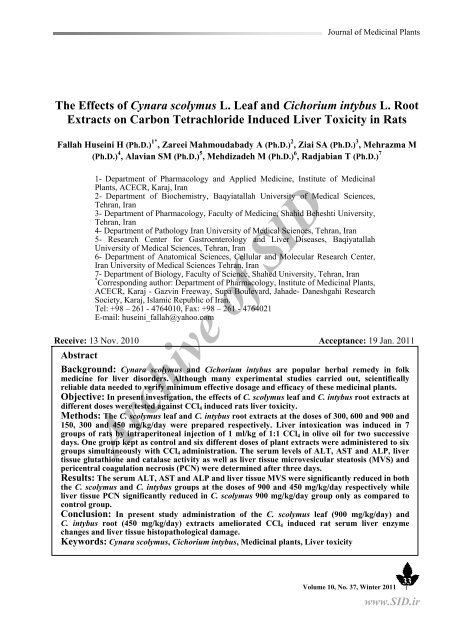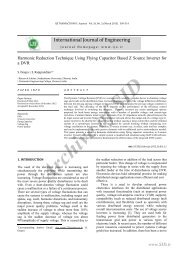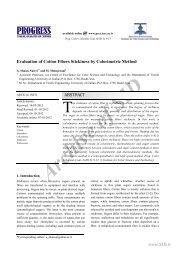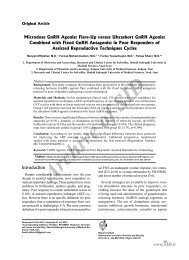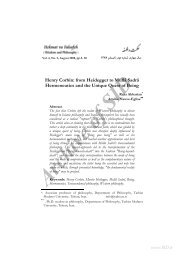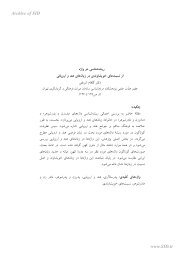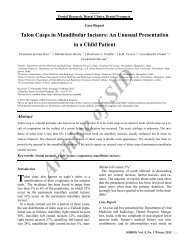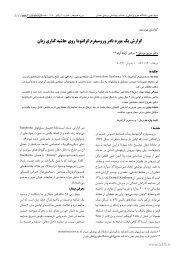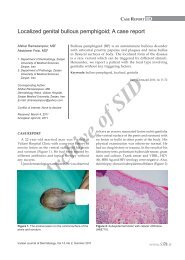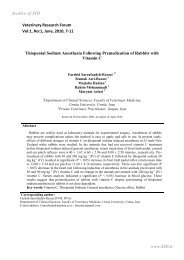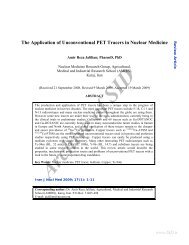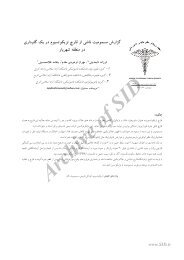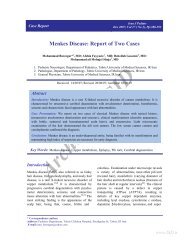THE EFFECTS OF CYNARA SCOLYMUS L. LEAF AND ...
THE EFFECTS OF CYNARA SCOLYMUS L. LEAF AND ...
THE EFFECTS OF CYNARA SCOLYMUS L. LEAF AND ...
Create successful ePaper yourself
Turn your PDF publications into a flip-book with our unique Google optimized e-Paper software.
Archive of SID<br />
Journal of Medicinal Plants<br />
The Effects of Cynara scolymus L. Leaf and Cichorium intybus L. Root<br />
Extracts on Carbon Tetrachloride Induced Liver Toxicity in Rats<br />
Fallah Huseini H (Ph.D.) 1* , Zareei Mahmoudabady A (Ph.D.) 2 , Ziai SA (Ph.D.) 3 , Mehrazma M<br />
(Ph.D.) 4 , Alavian SM (Ph.D.) 5 , Mehdizadeh M (Ph.D.) 6 , Radjabian T (Ph.D.) 7<br />
1- Department of Pharmacology and Applied Medicine, Institute of Medicinal<br />
Plants, ACECR, Karaj, Iran<br />
2- Department of Biochemistry, Baqyiatallah University of Medical Sciences,<br />
Tehran, Iran<br />
3- Department of Pharmacology, Faculty of Medicine, Shahid Beheshti University,<br />
Tehran, Iran<br />
4- Department of Pathology Iran University of Medical Sciences, Tehran, Iran<br />
5- Research Center for Gastroenterology and Liver Diseases, Baqiyatallah<br />
University of Medical Sciences, Tehran, Iran<br />
6- Department of Anatomical Sciences, Cellular and Molecular Research Center,<br />
Iran University of Medical Sciences Tehran, Iran<br />
7- Department of Biology, Faculty of Science, Shahed University, Tehran, Iran<br />
* Corresponding author: Department of Pharmacology, Institute of Medicinal Plants,<br />
ACECR, Karaj - Gazvin Freeway, Supa Boulevard, Jahade- Daneshgahi Research<br />
Society, Karaj, Islamic Republic of Iran.<br />
Tel: +98 – 261 - 4764010, Fax: +98 – 261 - 4764021<br />
E-mail: huseini_fallah@yahoo.com<br />
Receive: 13 Nov. 2010 Acceptance: 19 Jan. 2011<br />
Abstract<br />
Background: Cynara scolymus and Cichorium intybus are popular herbal remedy in folk<br />
medicine for liver disorders. Although many experimental studies carried out, scientifically<br />
reliable data needed to verify minimum effective dosage and efficacy of these medicinal plants.<br />
Objective: In present investigation, the effects of C. scolymus leaf and C. intybus root extracts at<br />
different doses were tested against CCl4 induced rats liver toxicity.<br />
Methods: The C. scolymus leaf and C. intybus root extracts at the doses of 300, 600 and 900 and<br />
150, 300 and 450 mg/kg/day were prepared respectively. Liver intoxication was induced in 7<br />
groups of rats by intraperitoneal injection of 1 ml/kg of 1:1 CCl4 in olive oil for two successive<br />
days. One group kept as control and six different doses of plant extracts were administered to six<br />
groups simultaneously with CCl4 administration. The serum levels of ALT, AST and ALP, liver<br />
tissue glutathione and catalase activity as well as liver tissue microvesicular steatosis (MVS) and<br />
pericentral coagulation necrosis (PCN) were determined after three days.<br />
Results: The serum ALT, AST and ALP and liver tissue MVS were significantly reduced in both<br />
the C. scolymus and C. intybus groups at the doses of 900 and 450 mg/kg/day respectively while<br />
liver tissue PCN significantly reduced in C. scolymus 900 mg/kg/day group only as compared to<br />
control group.<br />
Conclusion: In present study administration of the C. scolymus leaf (900 mg/kg/day) and<br />
C. intybus root (450 mg/kg/day) extracts ameliorated CCl4 induced rat serum liver enzyme<br />
changes and liver tissue histopathological damage.<br />
Keywords: Cynara scolymus, Cichorium intybus, Medicinal plants, Liver toxicity<br />
Volume 10, No. 37, Winter 2011<br />
33<br />
www.SID.ir
The Effects of …<br />
Introduction<br />
In Iranian traditional system of medicine<br />
Cynara scolymus L. and Cichorium intybus L.<br />
are used for treatment of several diseases<br />
including hepatic disorders [1 - 4]. The leaf<br />
extract of C. scolymus has shown to be<br />
effective in lowering blood cholesterol levels,<br />
improving digestion and liver functions [5-7].<br />
C. intybus root continues to be a popular<br />
herbal remedy for its healing effects in several<br />
ailments include gastrointestinal discomfort,<br />
gallstones, gout and rheumatism, lowering the<br />
blood<br />
58<br />
glucose and lipid, decreasing uric acid,<br />
and hepatoprotection [8-10]. The<br />
hepatoprotective effects of C. scolymus and C.<br />
intybus have been reported in experimental<br />
studies with different and some in very high<br />
doses [11-13]. In present study, however to<br />
find the hepatoprotective effect of C. scolymus<br />
leaf and C. intybus root extracts at lowest<br />
effective doses, three doses of 10, 20 and 30<br />
times higher than average doses used in human<br />
herbal therapy were tested against CCl4<br />
induced liver toxicity in rats.<br />
Materials and Methods<br />
Animals<br />
Eighty male Wistar rats aged 5 months and<br />
230-250 g weight, were purchased from<br />
Shahid Beheshti University animal house,<br />
Tehran, Iran. The animals were maintained<br />
under a daily controlled 12 / 12 hr light dark<br />
cycle at 23°C and 50% humidity with free<br />
access to rat chow and water. The study was<br />
approved by the Institutional Animals Ethics<br />
Committee of ACECR, Tehran Iran.<br />
Chemicals<br />
Dimethyl sulfoxide (DMSO), ERBA test<br />
kits, sulphosalicylic acid, 5, 5'-dithio-bis (2nitrobenzoicacid),<br />
ethylenediaminetetraacetic<br />
acid (EDTA), bovine serum albumin, CCl4,<br />
34<br />
Journal of Medicinal Plants, Volume 10,<br />
No. 37, Winter 2011<br />
GSH, 2-thiobarbituric acid, and other reagents<br />
of the highest grade were purchased from<br />
Sigma Chemical Co. (St. Louis, MO).<br />
Chemicals employed in these studies were<br />
reagent grade. All chemicals were used<br />
without further purification. CCl4 was diluted<br />
two-fold in olive oil.<br />
Plants material<br />
C. scolymus leaf and C. intybus root were<br />
collected from institutional field. The extracts<br />
preparation was performed by Institute of<br />
Medicinal Plant Tehran Iran. Briefly the dry<br />
plants materials were powdered and immersed<br />
in hydro-alcoholic (80%) solvent for 24 hours<br />
and filtered. The procedure repeated twice<br />
more for complete extraction of the<br />
phytochemicals. Concentrate the filtrate in<br />
rotavapor at 50°C, and lyophilized to get dry<br />
extract. Three concentrations of 300, 600 and<br />
900 mg/ml were prepared for C. scolymus leaf<br />
extract and three concentrations of 150, 300<br />
and 450 mg/ml were prepared for C. intybus<br />
root extract by dissolving dry extracts in 5%<br />
DMSO in distilled water.<br />
The above three doses are equally relative<br />
to 10, 20 and 30 times higher than average<br />
doses (2100 mg/day for C. scolymus leaf<br />
extract and 1050 mg/day for C. intybus root<br />
extract) used in human herbal therapy [3].<br />
Archive of SID<br />
Experimental protocol<br />
Administration of CCl4 and medicinal<br />
plants extract<br />
The rats were divided into eight groups of<br />
10 animals each. One group was kept as<br />
normal and liver damage were induced in 7<br />
groups by intra-peritoneal injection of 1 ml/kg<br />
body weight of 1:1 carbon tetrachloride in<br />
olive oil for two successive days by modified<br />
Zimmerman method [14]. Of 7 intoxicated<br />
www.SID.ir
groups one was kept as control and six<br />
different medicinal plants extracts were<br />
administered to remaining 6 groups. The<br />
medicinal plant extracts (dissolved in 5%<br />
DMSO in distilled water) were injected<br />
intraperitonealy for three days simultaneously<br />
with CCl4 administration.<br />
Experimental design<br />
Normal group: Olive oil and DMSO as<br />
vehicles were administered intraperitoneally to<br />
this group for two and three days respectively.<br />
Control group: DMSO as vehicle was<br />
administered intraperitoneally to this CCl4<br />
intoxicated group for three days.<br />
C. scolymus groups: C. scolymus root<br />
extract at the doses of 300, 600 and 900<br />
mg/kg/day were administered separately to<br />
three groups for three days.<br />
C. intybus groups: C. intybus root extract<br />
at the doses of 150, 300 and 450 mg/kg/day<br />
were administered separately to three groups<br />
for three days.<br />
Serum biochemical study<br />
Three days after the liver intoxication and<br />
medicinal plants extracts treatment, the blood<br />
samples were collected from rat's heart under<br />
chloroform anesthesia. The serum liver<br />
enzymes such as serum ALT, AST, and ALP<br />
were estimated in all groups by International<br />
Federation of Clinical Chemistry (ERBA test<br />
kits) method [15, 16]. All enzymes activities<br />
are expressed as international units (IU/l).<br />
Archive of SID<br />
Liver anti-oxidative study<br />
Sample preparation<br />
Immediately after the blood samples were<br />
collected under chloroform anesthesia, the<br />
animals were sacrificed and the residual<br />
bloods in liver as much as possible were<br />
removed by ice cold 0.9% NaCl perfusion and<br />
Fallah huseini & Authors<br />
then livers were removed from the bodies. The<br />
isolated livers were weighed and kept at<br />
−80°C as soon as possible until further use.<br />
For the assays of hepatic GSH and catalase, a<br />
part of liver was homogenized in 9 volumes of<br />
ice-cold 0.15 M KCl containing 1.0 mM<br />
EDTA using a glass homogenizer with a<br />
Teflon pestle. The homogenate was sonicated<br />
on ice twice × 30 s and centrifuged at<br />
12,000 × g for 15 min at 4°C. The supernatant<br />
was dialyzed against 100 volumes of the same<br />
buffered solution at 4°C for 60 min.<br />
Determination of GSH level and catalase<br />
activity in liver tissue<br />
The hepatic reduced GSH levels were<br />
determined by the method of Jollow et al. [17].<br />
Briefly, the supernatant samples were kept at<br />
4°C for at least 1 hour. The assay mixture<br />
contained 0.1 ml filtered aliquot, 2.7 ml<br />
phosphate/EDTA buffer (0.1 M, pH 7.4) and<br />
0.2ml of 5,5'-dithio-bis (2-nitrobenzoic acid)<br />
in a total volume of 3.0 ml. The yellow color<br />
developed was read immediately at 412 nm on<br />
a spectrophotometer. At each determination, a<br />
standard curve of glutathione was prepared.<br />
The catalase activity was measured by<br />
Bergmeyer method [18]. The enzymatic<br />
method of H2O2 decomposition was used for<br />
determination of Catalase activity. Protein in<br />
liver tissue samples was measured by using<br />
bovine serum albumin as a standard according<br />
to method of Lowry et al. [19].<br />
Determination of liver tissue<br />
histopathological injury<br />
Small piece of liver were removed and<br />
fixed in 10% buffered formalin for 24 hour,<br />
then dehydrated in ascending grades of alcohol<br />
cleared in xylene and embedded in paraffin<br />
wax (58-60%) all in automatic tissue<br />
processors. Sections were cut at 3µm, double<br />
35<br />
www.SID.ir
The Effects of …<br />
stained with hematoxylin - eosin and examined<br />
under the light microscope. The<br />
microvesicular steatosis and pericentral<br />
coagulation necrosis were determined as<br />
indication of CCl4 induced liver injury. The<br />
microvesicular steatosis and pericentral<br />
coagulation necrosis were graded as grade 0<br />
for no injury, grade 1 for low or below 30%<br />
injury, grade 2 for moderate or 30 - 60% injury<br />
and grade 3 for sever or above 60% injury [20].<br />
Statistical analysis<br />
All obtained values are expressed as the<br />
Journal of Medicinal Plants, Volume 10,<br />
No. 37, Winter 2011<br />
mean ± SD. All data were analyzed by<br />
computerized statistical packages (SPSS<br />
ver.11.5). Each mean value is compared by<br />
one-way analysis of variance and Tukey’s post<br />
hoc test. The level of significance was set at<br />
Serum liver enzymes<br />
In control group, a significant increase in<br />
serum alanine aminotransferase (ALT),<br />
aspartate aminotransferase (AST), and alkaline<br />
phosphates (ALP) concentration (1561 ± 196<br />
U/l, 1225 ± 254 U/l and 1200 ± 223 U/l,<br />
respectively) were recorded three days after<br />
CCl4 administration as compared to the normal<br />
group (112 ± 23 U/l, 63 ± 12 U/l and 340 ± 57<br />
U/l respectively). The statistical results did not<br />
showed in Table 1.<br />
In C. intybus root and C. scolymus leaf<br />
extract groups at the doses of 10 and 20 times<br />
of human doses (THD) the serum levels of liver<br />
enzymes did not differ as compared to the<br />
control group.<br />
In C. intybus root extract group at the dose<br />
of 450 mg/kg/day (30 THD) the serum ALT,<br />
AST and ALP levels (624 ± 51, 433 ± 60 and<br />
590±46 respectively) were significantly<br />
reduced (p
The Effects of …<br />
extracts treatment to CCl4 intoxicated rats at<br />
10 and 20 times of human doses (THD) did<br />
not influence the liver toxicity, where as at<br />
higher doses i.e. 30 THD administration of<br />
these medicinal plants extracts attenuated the<br />
decrease in liver toxicity as indicated by serum<br />
liver enzymes level lowering effect and<br />
amelioration in histopathological changes in<br />
the liver tissue. However, we failed to observe<br />
any effect of C. scolymus leaf and C. intybus<br />
root extracts on liver tissue GSH level and<br />
catalase activities. The underlying mechanism<br />
for hepatoprotective effects of C. scolymus<br />
leaf and C. intybus root extract remains to be<br />
elucidated.<br />
In C. scolymus leaf extract several<br />
compounds such as cynarin, caffeic acid,<br />
chlorogenic acid, luteolin and other flavonoids<br />
and polyphenol compounds, some with<br />
antioxidant properties have been found [23-<br />
25]. Adzet T et al., reported that, the<br />
hepatoprotective effect of C. scolymus may be<br />
due to its chlorogenic acid and cynarin content<br />
[12] and other study proposed that, the<br />
protective effect of C. scolymus leaf extract on<br />
CCl4 induced acute liver injury may be due to<br />
its antioxidative property [25]. In C. intybus<br />
root a phenolic compound esculetin, is known<br />
for anti-hepatotoxic activity [10, 26]. Zafar R,<br />
and Mujahid Ali S. proposed that, the<br />
hepatoprotective effect of C. intybus root<br />
extract may be due to its ability to suppress the<br />
oxidative degradation of DNA in the tissue<br />
debris [13].<br />
Journal of Medicinal Plants, Volume 10,<br />
No. 37, Winter 2011<br />
Archive of SID<br />
However, in present study we observed the<br />
liver protective activity of C. scolymus leaf<br />
and C. intybus root extracts without significant<br />
effect on the liver tissue GSH level and<br />
catalase activity as markers of body antioxidative<br />
defense system. This indicate that<br />
the observed protective effects on CCl4<br />
induced liver injury in this study may not be<br />
due to anti-oxidative activities of the two<br />
38<br />
extracts only, as demonstrated in other studies<br />
[14, 22].<br />
Overall, to explain the observed<br />
hepatoprotective effects of C. scolymus leaf<br />
and C. intybus root extract in the present study,<br />
it is important to remember that following<br />
CCl4 induced acute liver injury; several<br />
important basic mechanisms such as reactive<br />
free radical metabolites formation, lipid<br />
peroxidation, covalent binding and disturbance<br />
of calcium homeostasis are involved in tissue<br />
damage [27]. In addition, inflammation and<br />
regeneration are other important modifying<br />
factors in the tissue injury [27]. However, the<br />
observed effects of C. scolymus leaf and<br />
C. intybus root extract against CCl4<br />
intoxication in present study may be due to the<br />
direct or indirect favorable effect of medicinal<br />
plants on liver cellular metabolism,<br />
inflammation and regeneration.<br />
Conclusion<br />
The present findings indicated that, the<br />
administration of C. scolymus L. leaf and<br />
C. intybus L. root extract at the doses of 900<br />
mg/kg/day and 450 mg/kg/day respectively or<br />
30 THD to CCl4 intoxicated rats, prevent liver<br />
toxicity and liver histopathological changes<br />
without significant influence on hepatic<br />
antioxidant properties. Further studies are<br />
required to evaluate the efficacy of combined<br />
administration of both medicinal plant extracts<br />
at different doses in experimental studies.<br />
Acknowledgements<br />
This study was supported by a research<br />
Grant # 1297-33-24/8/1388 from the ACECR<br />
Deputy Research Tehran, Iran. We thank the<br />
administration of the Institute of Medicinal<br />
Plants for their support in providing the<br />
necessary facilities for conducting this study.<br />
www.SID.ir
References<br />
1. Schuppan, Jia DJ, Brikhaus B, Hahn EG.<br />
Herbal products for liver disease: A<br />
therapeutic challenge for the new millennium.<br />
Hepatology 1999; 30: 1099 - 104.<br />
2. Chevallier A. The Encyclopedia of<br />
Medicinal Plants. New York, NY: DK<br />
Publishing. 1996, pp: 96 - 7.<br />
3. Haji Sharifi A. Cynara scolymus L.<br />
Cichorium intybus L. In Secrets of Herbal<br />
Medicine. Noskh-e-Shafa. 3 rd ed. Hafez<br />
Novin Press. Tehran Iran. 2003, 820 - 59.<br />
4. Compilation Committee of Iranian Herbal<br />
Pharmacoepia. Cynara scolymus L.<br />
Cichorium intybus L. In Iranian Herbal<br />
Pharmacoepia. Vol. 2, Ministry of Health and<br />
Medical Education, Tehran Iran. 2002, pp:<br />
582 - 669.<br />
5. Bundy R, Walker AF, Middleton RW,<br />
Wallis C, Simpson HC. Artichoke leaf extract<br />
(Cynara scolymus) reduces plasma<br />
cholesterol in otherwise healthy<br />
hypercholesterolemic adults: a randomized,<br />
double blind placebo controlled trial.<br />
Phytomedicine 2008; 15: 668 - 75.<br />
6. ESCOP (Europian Scientefic Corporative<br />
On Phytotherapy), Monographs. The<br />
Scientific Foundation of Herbal Medicinal<br />
Products- cyanara folium, artichoke leaf:<br />
Thieme, 2003, pp: 118 - 25.<br />
7. Kraft K. Artichoke leaf extract. Recent<br />
findings reflecting effects on lipid<br />
metabolism, liver and gastrointestinal tracts.<br />
Phytomedicine 1997; 4 (4): 369 - 78.<br />
8. Ripoll C, Flourié B, Megnien S, Hermand<br />
O, Janssens M. Gastrointestinal tolerance to<br />
an inulin-rich soluble roasted chicory extract<br />
after consumption in healthy subjects.<br />
Nutrition 2009; 18: 799 - 803.<br />
Archive of SID<br />
Fallah huseini & Authors<br />
9. Howard, M. Traditional Folk Remedies.<br />
United Kingdom, David & Charles,<br />
Publishing. 1987, p. 120.<br />
10. Wang Q, Cui J. A review on pharmic<br />
effect of chicory research and development.<br />
Zhongguo Zhong Yao Za Zhi. 2009; 34 (17):<br />
2269 - 72.<br />
11. Speroni E, Cervellati R, Govoni P,<br />
Guizzardi S, Renzulli C, Guerra MC. Efficacy<br />
of different Cynara scolymus preparations on<br />
liver complaints. J. Ethnopharmacol. 2003;<br />
86 (2-3): 203 - 11.<br />
12. Adzet T, Camarasa J, Laguna JC.<br />
Hepatoprotective activity of polyphenolic<br />
compounds from Cynara scolymus against<br />
carbon tetrachloride toxicity in isolated rat<br />
hepatocytes. J. Nat. Prod. 1987; 50: 612 - 17.<br />
13. Zafar R, Mujahid Ali S. Anti-hepatotoxic<br />
effects of root and root callus extracts of<br />
Cichorium intybus L. J. Ethnopharmacol.<br />
1998; 63 (3): 227 - 31.<br />
14. Zimmerman H J. Hepatotoxicity. The<br />
adverse effects of drugs and other chemicals<br />
on the liver. In: Carbon Tetrachloride. New<br />
York: Appleton-Century-Crofts, 1979, pp:<br />
198 - 217.<br />
15. International Federation of Clinical<br />
Chemistry and Laboratory Medicine (IFCC).<br />
Methods for the measurement of catalytic<br />
concentrations of enzymes. Part 3. IFCC<br />
method for alanine aminotransferase. Clin.<br />
Chim. Acta. 1980; 105: F145 – 72.<br />
16. Recommendations of the German Society<br />
for Clinical Chemistry. Standardisation of<br />
methods for the estimation of enzyme<br />
activities in biological fluids. Experimental<br />
basis for the optimized standard conditions. Z.<br />
Klin. Chem. Klin. Biochem. 1972; 10: 281 –<br />
39<br />
www.SID.ir
The Effects of …<br />
91.<br />
17. Jollow DJ, Mitchell JR, Zampaglione N,<br />
Gillette JR. Bromobenzene-induced liver<br />
necrosis. Protective role of glutathione and<br />
evidence for 3,4-bromobenzene oxide as the<br />
hepatotoxic metabolite. Pharmacology 1974;<br />
11 (3): 151 - 69.<br />
18. Bergmeyer H.U. Zur Mesung von<br />
Katalase-Activitäten. Biochem. Zeit. 1955;<br />
327: 255 – 8.<br />
19. Lowry OH, Rosebrough NH, Farr AD,<br />
Randall RJ. Protein measurement with the<br />
Folin reagent. J. Biol. Chem. 1951; 193: 265 –<br />
73.<br />
20. Kumar V, Abbas AK, Fausto N.<br />
Pathologic Basis of disease.7 th ed.<br />
Philadelphia, Saunders. 2005, pp: 25 - 6.<br />
21. Ahmad FF, Cowan DL, Sun AY.<br />
Detection of free radical formation in various<br />
tissues after acute carbon tetrachloride<br />
administration in gerbil. Life Sci. 1987; 41<br />
(22): 2469 - 75.<br />
22. Szymonik-Lesiuk S, Czechowska G,<br />
Stryjecka-Zimmer M, Słomka M, Madro A,<br />
Celiński K, et al. Catalase, superoxide<br />
dismutase, and glutathione peroxidase<br />
40<br />
Journal of Medicinal Plants, Volume 10,<br />
No. 37, Winter 2011<br />
activities in various rat tissues after carbon<br />
tetrachloride. J. Hepato. Biliary Pancreat.<br />
Surg. 2003; 10 (4): 309 - 15.<br />
23. Gebhardt R. Antioxidative and protective<br />
properties of extracts from leaves of the<br />
artichoke (Cynara scolymus L.) against<br />
hydroperoxide-induced oxidative stress in<br />
cultured rat hepatocytes. Toxicol. Appl.<br />
Pharmacol. 1997; 144 (2): 279 – 86.<br />
24. Wang M, Simon JE, Aviles IF, He K,<br />
Zheng QY, Tadmor Y. Analysis of<br />
antioxidative phenolic compounds in<br />
artichoke (Cynara scolymus L.). J. Agric.<br />
Food Chem. 2003; 51 (3): 601 - 8.<br />
25. Jiménez-Escrig A, Dragsted LO,<br />
Daneshvar B, Pulido R, Saura-Calixto F . In<br />
vitro antioxidant activities of edible artichoke<br />
(Cynara scolymus L.) and effect on<br />
biomarkers of antioxidants in rats. J. Agric.<br />
Food Chemi. 2003; 51 (18): 5540 - 5.<br />
26. Gadgoli C, Mishra SH. Antihepatotoxic<br />
activity of Cichorium intybus. J.<br />
Ethnopharmacol. 1997; 58 (2): 131 - 4.<br />
27. Masuda Y. Learning toxicology from<br />
carbon tetrachloride-induced hepatotoxicity.<br />
Yakugaku Zasshi 2006; 126 (10): 885 - 99.<br />
Archive of SID<br />
www.SID.ir


